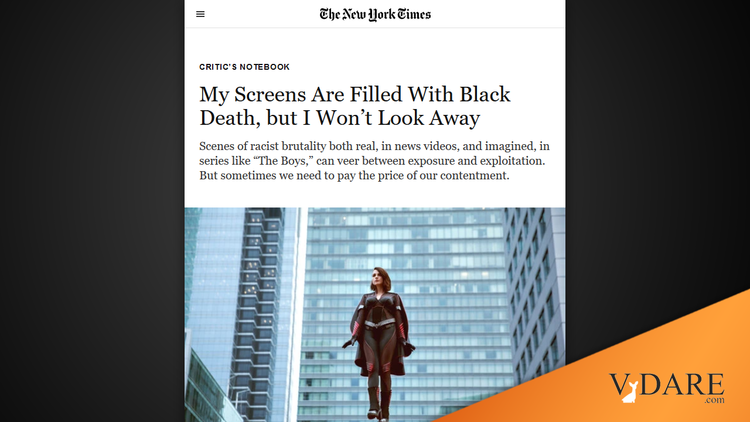My Screens Are Filled With Black Death, but I Won’t Look Away
Scenes of racist brutality both real, in news videos, and imagined, in series like “The Boys,” can veer between exposure and exploitation. But sometimes we need to pay the price of our contentment.
By Maya Phillips, Oct. 2, 2020
This essay includes spoilers from the current season of “The Boys.”
The most recent episode of Amazon’s superhero spoof “The Boys” opens with a gun-toting white man killing a South Asian storekeeper while hateful rhetoric about dangerous illegal immigrants runs through his head. Later at a public rally, two heroes decry “godless, inhuman supervillains” who are “pouring across our borders” while standing in front of a giant American flag.
And to think that when I watched the episode screener recently, I had turned to it for a break from news stories about senseless murders of people of color and the poisonous, racist discourse that’s become the norm in my supposedly great country. But this season of the series delivers more of the same: I was asked to watch more Black men die.
The show’s fictional renderings of Black deaths pale in comparison to the real tragedies they mirror. But I found their effect to be similarly distressing, and the presentations of both raise ethical questions about how we convey the horrors of America. When is this documenting of wrongs, as art or as journalism, a worthwhile public service intended to awaken people to what’s happening in their country? And when is it simply exploiting tragedy for the sake of spectacle?
Adapted from Garth Ennis’s notoriously graphic comic book of the same name, “The Boys” has never been light viewing. But it has a dark sense of humor, and the explicit violence has a point, as part of a larger critique of capitalism, consumerism, jingoism and the American obsession with celebrity. In the show’s alternative version of the world, superheroes are everywhere, and the best — an adored group called the Seven — are backed by an evil corporation, Vought International.
But unbeknown to their fans, the corrupt crusaders would rather pursue their own hedonistic, and often criminal, interests than save the day. A group of literal antiheroes, the Boys, work to get back at the “supes,” in the show’s parlance, for their misdeeds and keep them in line.
The second season narrows its gaze to focus on a timely topic: the power of hateful, fear-mongering political rhetoric. To that end, the show introduces a brand-new member of the Seven: Stormfront, an ageless wonder, played by Aya Cash, who we discover fought previously under the nom de guerre Liberty and was a member of the Nazi elite during World War II.
The Stormfront of the comic is a savage Nazi man in a cape, a fierce, powerful hero who openly terrorizes people of color. The series switches the gender and makes the unveiling of her villainy more subtle: She is a white feminist who challenges sexist double standards but then mobilizes her fans, first via social media and then at raucous rallies, manipulating people’s fears to her advantage. Her bigotry is revealed gradually, but as we see in flashbacks from when she was Liberty, it runs deep.
In one triggering scene set in the ’70s, Liberty stops a Black man and his younger sister as they’re driving along at night. The superhero cites a car robbery, though the man insists the car is his. Nevertheless, Liberty kills the man as his sister watches.
In the present day, as Stormfront, she chases a superpowered character into an apartment complex full of Black families, thoughtlessly killing bystanders along the way. She flings a Black man against his own refrigerator and he dies in his home, and it’s implied that the rest of his family does, too. She tosses another out of a window as if he were a piece of trash. When she reaches her target, an Asian man, she kills him slowly, cruelly, spitting out a racial epithet as she does. Later, at a rally, we see her proclaiming the need to “Keep America safe again,” in an explicit callback to our president’s favorite catchphrase.
Then there’s that opening scene of the episode released on Friday, when a random white Stormfront fan, infected by her rabble-rousing racism, shoots the man at his own convenience store, afraid that he is one of the immigrant superterrorists he has been warned about.

